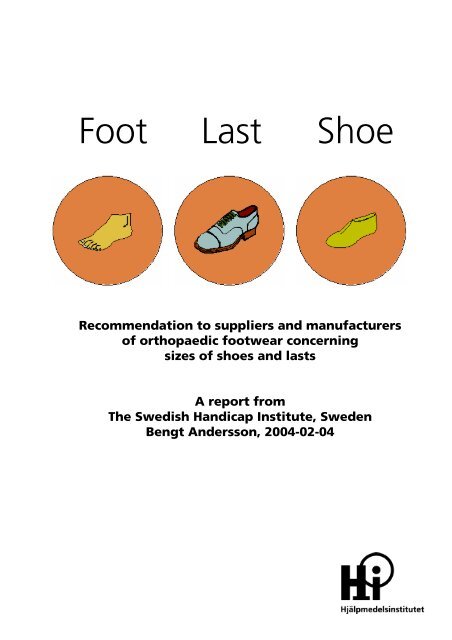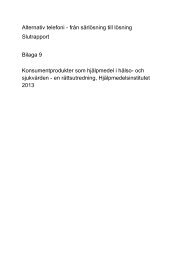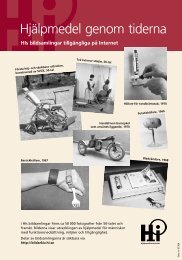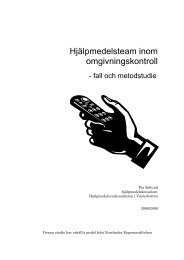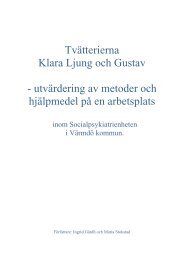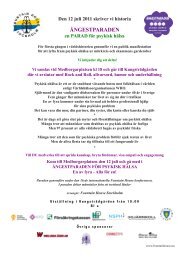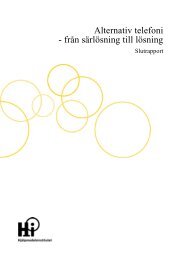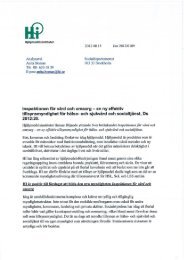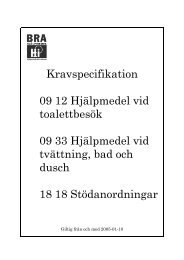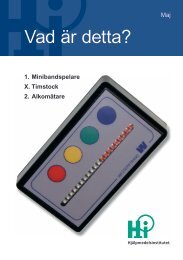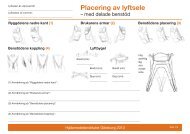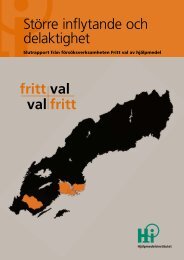Foot Last Shoe
Foot Last Shoe
Foot Last Shoe
You also want an ePaper? Increase the reach of your titles
YUMPU automatically turns print PDFs into web optimized ePapers that Google loves.
=<br />
=<br />
= cççí= i~ëí= pÜçÉ=<br />
=<br />
=<br />
=<br />
=<br />
=<br />
=<br />
=<br />
=<br />
=<br />
=<br />
=<br />
oÉÅçããÉåÇ~íáçå=íç=ëìééäáÉêë=~åÇ=ã~åìÑ~ÅíìêÉêë=<br />
çÑ=çêíÜçé~ÉÇáÅ=ÑççíïÉ~ê=ÅçåÅÉêåáåÖ=<br />
ëáòÉë=çÑ=ëÜçÉë=~åÇ=ä~ëíë=<br />
=<br />
=<br />
^=êÉéçêí=Ñêçã=<br />
qÜÉ=pïÉÇáëÜ=e~åÇáÅ~é=fåëíáíìíÉI=pïÉÇÉå=<br />
_ÉåÖí=^åÇÉêëëçåI=OMMQJMOJMQ=
© The Swedish Handicap Institute 2004<br />
Text: Bengt Andersson, SHI<br />
Illustrations: Peter Wahlström and Bengt Andersson<br />
Translation: Bengt Andersson, SHI and Fiona Barnett, Advanced Prosthetic, Australia<br />
Published as PDF on www.hi.se<br />
URN:NBN: se-2004-xxx<br />
Order no. 04319-pdf
<strong>Foot</strong>, last, shoe 2004-02-04<br />
Bengt Andersson, The Swedish Handicap Institute<br />
pìãã~êó=<br />
For people that are dependent upon orthopaedic shoes, eg those with diabetes or<br />
rheumatism, it is essential that their shoes are well fitted, that they are<br />
comfortable and functional, as this ensures that they will not cause any problems<br />
such as blisters. Several orthopaedic workshops and the Swedish Trade<br />
Organisation for orthopaedics have called upon The Swedish Handicap Institute<br />
(SHI) to chart the problems with the different systems of shoe sizes, as well as<br />
the problems associated with differences in sizes in the same size system.<br />
Lack of a universal and uniform shoe-size-system creates problems when it comes<br />
to ordering prefabricated orthopaedic footwear. The fit of a shoe is due to many<br />
parameters but the most basic is the length of the shoe. Suppliers of<br />
prefabricated orthopaedic shoes use different length and shoe size systems, which<br />
can lead to errors when ordering shoes. This lack of standardisation creates a<br />
”loose situation” for all involved; the patients, the orthopaedic workshop and the<br />
suppliers.<br />
SHI in cooperation with Code of Practice in Sweden has documented the existing<br />
systems of shoe sizes and the different ways in which to measure a last. The<br />
metric system, Mondopoint, is presented and described as it is the international<br />
standard for shoe sizes as endorsed by ISO 9407:1991. Mondopoint is used by<br />
NATO and the Swedish defence, as well as some manufacturers of ski boots and<br />
is an unambiguous system that is especially functional when ordering<br />
prefabricated orthopaedic footwear.<br />
Based on the information documented by this project, The Swedish Handicap<br />
Institute has composed the recommendations below to remove all possible errors<br />
in the process of ordering orthopaedic footwear:<br />
=<br />
=<br />
=<br />
=<br />
=<br />
=<br />
=<br />
=<br />
=<br />
=<br />
=<br />
=<br />
=<br />
=<br />
=<br />
=<br />
=<br />
=<br />
=<br />
=<br />
=<br />
=<br />
oÉÅçããÉåÇ~íáçå=íç=ã~åìÑ~ÅíìêÉêë=~åÇ=ëìééäáÉêë=çÑ=çêíÜçé~ÉÇáÅ=ÑççíïÉ~êW=<br />
qç=Ñ~Åáäáí~íÉ=çêÇÉêáåÖ=éêÉÑ~ÄêáÅ~íÉÇ=çêíÜçé~ÉÇáÅ=ÑççíïÉ~êI=íÜÉ=ã~åìÑ~ÅíìêÉêë=~åÇ=<br />
ëìééäáÉêë=çÑ=çêíÜçé~ÉÇáÅ=ÑççíïÉ~ê=~êÉ=êÉÅçããÉåÇÉÇ=íçW==<br />
=<br />
- ÇÉÅä~êÉ=íÜÉáê=éêçÇìÅíë=ëáòÉë=~ÅÅçêÇáåÖ=íç=fpl=VQMTWNVVN=pÜçÉ=ëáòÉë=Ó=<br />
jçåÇçéçáåí=ëóëíÉã=çÑ=ëáòáåÖ=~åÇ=ã~êâáåÖK==<br />
=<br />
^ë=~å=~äíÉêå~íáîÉLÇìêáåÖ=íÜÉ=íê~åëáíáçå~ä=éÉêáçÇI íÜÉ=ã~åìÑ~ÅíìêÉêë=~åÇ=ëìééäáÉêë=~êÉ=<br />
êÉÅçããÉåÇÉÇ=íçI=~ë=~=ÅçãéäÉãÉåí=íç=íÜÉ=ÉñáëíáåÖ=áåÑçêã~íáçå=éêçîáÇÉÇI=ÇÉÅä~êÉW==<br />
=<br />
- áå=ïêáííÉå=ÑçêãI=ëìÅÜ=~ë=ã~åì~äëI=íÜÉ=éêçÇìÅíÛë=äÉåÖíÜ=çÑ=ä~ëí=áå=ãã==<br />
=<br />
- áå=ïêáííÉå=ÑçêãI=ëìÅÜ=~ë=ã~åì~äëI=íÜÉ=íÉÅÜåáèìÉ=ìëÉÇ=áå=íÜÉ=ãÉ~ëìêÉãÉåí=çÑ=<br />
íÜÉ=ä~ëíW=<br />
=<br />
NK=qÜÉ=ä~ëí=ãÉ~ëìêÉÇ=Ñêçã=íÜÉ=íáé=çÑ=íÜÉ=íçÉ=íç=íÜÉ=~éÉñ=çÑ=íÜÉ=ÜÉÉä=ëí~åÇáåÖ<br />
====ïáíÜ=áåíÉåÇÉÇ=ÜÉÉä=ÜÉáÖÜí==<br />
===========OK=qÜÉ=ä~ëí=ãÉ~ëìêÉÇ=Ñêçã=íÜÉ=íáé=çÑ=íÜÉ=íçÉ=íç=íÜÉ=~éÉñ=çÑ=íÜÉ=ÜÉÉä===<br />
===============ïáíÜçìí=áåíÉåÇÉÇ=ÜÉÉä=ÜÉáÖÜíK=====<br />
===========PK=jÉ~ëìêáåÖ=íÜÉ=áåëçäÉ=çÑ=íÜÉ=ä~ëí=Ñêçã=íÜÉ=íáé=çÑ=íÜÉ=íçÉ=íç=íÜÉ=Ä~ëÉ=çÑ=íÜÉ=<br />
===============ÜÉÉä==<br />
3
<strong>Foot</strong>, last, shoe 2004-02-04<br />
Bengt Andersson, The Swedish Handicap Institute<br />
=<br />
=<br />
=<br />
=<br />
q~ÄäÉ=çÑ=ÅçåíÉåíë=<br />
=<br />
pìãã~êó KKKKKKKKKKKKKKKKKKKKKKKKKKKKKKKKKKKKKKKKKKKKKKKKKKKKKKKKKKKKKKKKKKKKKKKKKKKKKKKKKKKKKKKKKKKKKKKKKP<br />
q~ÄäÉ=çÑ=ÅçåíÉåíë KKKKKKKKKKKKKKKKKKKKKKKKKKKKKKKKKKKKKKKKKKKKKKKKKKKKKKKKKKKKKKKKKKKKKKKKKKKKKKKKKKKKQ<br />
_~ÅâÖêçìåÇ KKKKKKKKKKKKKKKKKKKKKKKKKKKKKKKKKKKKKKKKKKKKKKKKKKKKKKKKKKKKKKKKKKKKKKKKKKKKKKKKKKKKKKKKKKKKKR<br />
mìêéçëÉ=~åÇ=~áã KKKKKKKKKKKKKKKKKKKKKKKKKKKKKKKKKKKKKKKKKKKKKKKKKKKKKKKKKKKKKKKKKKKKKKKKKKKKKKKKKKKKKR<br />
mêçàÉÅí=ÅççéÉê~íáçå KKKKKKKKKKKKKKKKKKKKKKKKKKKKKKKKKKKKKKKKKKKKKKKKKKKKKKKKKKKKKKKKKKKKKKKKKKKKKKKKS<br />
cççíI=ä~ëíI=ëÜçÉKKKKKKKKKKKKKKKKKKKKKKKKKKKKKKKKKKKKKKKKKKKKKKKKKKKKKKKKKKKKKKKKKKKKKKKKKKKKKKKKKKKKKKKKS<br />
tÜ~í=áë=~=ëÜçÉ=ëáòÉ\ ............................................................................................................. 6<br />
p~ãÉ=ëÜçÉ=ëáòÉ=Ó=ä~êÖÉ=äÉåÖíÜ=ÇáÑÑÉêÉåÅÉë> ........................................................................ 7<br />
qÜÉ=äÉåÖíÜ=çÑ=íÜÉ=ä~ëí ........................................................................................................... 8<br />
jçåÇçéçáåí=Ó=~=ãÉíêáÅ=ëÜçÉ=ëáòÉ=ëóëíÉã ........................................................................... 9<br />
oÉÅçããÉåÇ~íáçå=íç=ëìééäáÉêë=~åÇ=ã~åìÑ~ÅíìêÉêë=çÑ=çêíÜçé~ÉÇáÅ=<br />
ÑççíïÉ~ê=ÅçåÅÉêåáåÖ=ëáòÉë=çÑ=ëÜçÉë=~åÇ=ä~ëíëKKKKKKKKKKKKKKKKKKKKKKKKKKKKKKKKKKKKNM<br />
=<br />
=<br />
=<br />
=<br />
=<br />
=<br />
=<br />
=<br />
=<br />
=<br />
=<br />
=<br />
=<br />
=<br />
=<br />
=<br />
=<br />
=<br />
=<br />
=<br />
=<br />
4
<strong>Foot</strong>, last, shoe 2004-02-04<br />
Bengt Andersson, The Swedish Handicap Institute<br />
_~ÅâÖêçìåÇ=<br />
It can be difficult to find shoes that fit well! Although we know what shoe size we<br />
“normally” require, sometimes we may have to try on many different shoe sizes to<br />
find the one which fits the best. Yet we all still seem to have shoes in the<br />
cupboard that we never use as they are uncomfortable and gives us blisters.<br />
Although this is a common problem, for those people who are dependent upon<br />
having orthopaedic shoes, eg those with diabetes or rheumatism, this is a<br />
significant problem, as their shoes must be comfortable, well fitted and<br />
functional!<br />
The fit of a shoe is based upon many parameters but the most basic of these is<br />
the length of the shoe. The shoe can not be too long or too short. The lack of a<br />
universal and uniform shoe-size-system creates problems when it comes to<br />
ordering prefabricated orthopaedic shoes from an external source. Several<br />
orthopaedic workshops (OWs) in Sweden have acknowledged this and asked The<br />
Swedish Handicap Institute (SHI) to investigate the problem. The Swedish Trade<br />
Association for orthopaedics, OTB, has also called upon SHI to take action in this<br />
matter.<br />
Suppliers of prefabricated orthopaedic shoes use different length and shoe size<br />
systems, which creates confusion and lead to potential errors when ordering<br />
shoes. This lack of standardisation creates a very ”loose situation” for all<br />
involved. In the worst case scenario the patient may receive inappropriate shoes,<br />
ie those that are either too large or too small. This error though, will generally be<br />
picked up at the point of fitting in the OW which will require the patient to<br />
return at a later date to try a different pair of shoes. For the OW this lack of<br />
standardisation causes unprofitable extra work, with the shoes having to be<br />
returned and exchanged with the supplier and the subsequent rescheduling of<br />
another fitting with the patient. For the supplier the return also generates extra<br />
work, along with extra charges not only in time wasted but freight costs. In<br />
addition it must also be pointed out that several suppliers have changed last<br />
sizes for certain shoe models and the OWs have to struggle with different length<br />
sizes even within one suppliers catalogue.<br />
This situation is intolerable as almost 50% of the total annual turnover of OWs in<br />
Sweden today is based around assistive devices for foot problems.(1).<br />
mìêéçëÉ=~åÇ=~áã=<br />
The purpose of this project was to:<br />
- produce a recommendation to suppliers and manufacturers of orthopaedic<br />
footwear as to how to specify shoe and last sizes, in order to minimize<br />
misunderstandings and errors.<br />
- document existing shoe-size-systems and ongoing national and<br />
international projects in this area.<br />
The aim was to:<br />
- compose recommendations for suppliers and manufacturers in order to<br />
make it easier to order correct sizes of orthopaedic footwear, based upon<br />
measurements taken of the patient’s feet at the OW.<br />
5
<strong>Foot</strong>, last, shoe 2004-02-04<br />
Bengt Andersson, The Swedish Handicap Institute<br />
mêçàÉÅí=ÅççéÉê~íáçå=<br />
The work has been carried out in cooperation with SHI and the specialist<br />
network, Code of Practice in Sweden (CoP). For more information about CoP;<br />
www.codeofpractice.se/english/ . The main documentation has been done by shoe<br />
modeller Peter Wahlström, who has also produced the illustrations.<br />
cççíI=ä~ëíI=ëÜçÉ=<br />
There are several size systems used all over the world. Although there are<br />
general rules for comparison between the systems, these comparisons cannot be<br />
relied upon, due to a lack of coordination as to how each of these systems are<br />
applied in each country. There is also a lack of information as to how the<br />
manufacturers have defined the size of the last for the shoe.<br />
tÜ~í=áë=~=ëÜçÉ=ëáòÉ\=<br />
It is important to note the difference between foot<br />
length and shoe size. <strong>Foot</strong> length in Europe (except<br />
UK) is always measured in millimetres (mm). The size<br />
of shoes is specified with different size terms<br />
depending upon which system is in use. There are also<br />
different opinions as to how long a shoe should be in proportion to the foot, but<br />
generally one can say that a shoe should be 12-15 mm longer than the foot<br />
depending of the shoe design.<br />
=<br />
=<br />
=<br />
Most size systems will specify the shoe size based upon the<br />
nominal length of the last, which corresponds to the length of the inside of the<br />
shoe. Therefore, all shoes designated with the same size will not necessarily be of<br />
the same length due to the shape of the last. A shoe with a low heel and wide toe<br />
shape is probably close to the specified shoe size in length if you measure the<br />
last. A shoe with a narrow toe shape will be longer then its specified shoe size.<br />
=<br />
=<br />
=<br />
=<br />
=<br />
=<br />
=<br />
=<br />
=<br />
=<br />
=<br />
=<br />
=<br />
=<br />
=<br />
6
<strong>Foot</strong>, last, shoe 2004-02-04<br />
Bengt Andersson, The Swedish Handicap Institute<br />
=<br />
páòÉ=ëóëíÉãë=<br />
There are several size systems used all over<br />
the world. Sweden and most of Europe,<br />
except UK and Ireland, use the system called Paris<br />
Point. In Sweden size 38 for women and size 43 for<br />
men are most common. The scale starts at zero and<br />
continues with length intervals of 6,66 mm per size.<br />
The Paris Point-system is sometimes called the<br />
Continental System. The difference between<br />
each system is that the length of the last is measured<br />
differently. English and American sizes are also<br />
used in Sweden, mainly for sportswear.<br />
In the illustration to the right you can compare<br />
the differences between each of the shoe size systems.<br />
As can be seen, you may have the same shoe size<br />
but a different length, depending on which system<br />
you are utilising.<br />
=<br />
=<br />
p~ãÉ=ëÜçÉ=ëáòÉ=Ó=ä~êÖÉ=äÉåÖíÜ=ÇáÑÑÉêÉåÅÉë>=<br />
In this project we studied the information from<br />
3 suppliers of 5 different prefabricated orthopaedic<br />
shoes. We found that there are large length differences<br />
between shoes with the same shoe size. The<br />
information below is collated from the suppliers<br />
brochures and provides information of shoe size<br />
and shoe inside lengthW=<br />
=<br />
=<br />
=<br />
pìééäáÉê= pÜçÉ= =======páòÉ=Em~êáë=mçáåíF= pÜçÉ=áåëáÇÉ=äÉåÖíÜ=<br />
=<br />
^==================~êíáÅäÉ=N= = ëáòÉ=QP= OUN=ããK==<br />
_==================~êíáÅäÉ=O= =============ëáòÉ=QP= OVN=ããK=<br />
`=================~êíáÅäÉ=P= = ëáòÉ=QP= OTR=ããK=<br />
`=================~êíáÅäÉ=Q= = ëáòÉ=QP= OUO=ããK=<br />
`=================~êíáÅäÉ=R= = ëáòÉ=QP= OUU=ããK=<br />
=<br />
=<br />
As can be seen there are significant differences in shoe inside lengths. The<br />
largest difference found between shoes of the same size was 16 mm! This is just<br />
one example of what you can find if you compare shoes from different suppliers.<br />
It should also be noted that no supplier provided information as to what their<br />
measures indicated or how they were taken.<br />
=<br />
7
<strong>Foot</strong>, last, shoe 2004-02-04<br />
Bengt Andersson, The Swedish Handicap Institute<br />
qÜÉ=äÉåÖíÜ=çÑ=íÜÉ=ä~ëí=<br />
As indicated above there are significant differences, up to 16 mm, between shoes<br />
with the same size. These length differences appear for shoes with the same size,<br />
in the same shoe system, if the lasts are measured differently. To be able to<br />
compare the length of shoes with the same size it is essential to know how the<br />
lasts have been measured. The conclusion, after consultation with the<br />
manufacturers and suppliers, is that there are three different ways in which a<br />
last may be measured. These three different techniques are presented below:<br />
=<br />
NK=qÜÉ=ä~ëí=áë=ãÉ~ëìêÉÇ=Ñêçã=íÜÉ=íáé=çÑ=íÜÉ=íçÉ=íç=íÜÉ=~éÉñ=çÑ=íÜÉ=ÜÉÉä=ïáíÜ=íÜÉ=<br />
áåíÉåÇÉÇ=ÜÉÉä=ÜÉáÖÜí==<br />
=<br />
=<br />
=====<br />
=<br />
=<br />
=<br />
=<br />
=<br />
=<br />
=<br />
=<br />
=<br />
=<br />
OK==qÜÉ=ä~ëí=áë=ãÉ~ëìêÉÇ=Ñêçã=íÜÉ=íáé=çÑ=íÜÉ=íçÉ=íç=íÜÉ=~éÉñ=çÑ=íÜÉ=ÜÉÉä=ïáíÜçìí=<br />
íÜÉ=áåíÉåÇÉÇ=ÜÉÉä=ÜÉáÖÜíK=====<br />
=<br />
=<br />
=<br />
=<br />
=<br />
=<br />
=<br />
=<br />
=<br />
=<br />
=<br />
PK=qÜÉ=áåëçäÉ=çÑ=íÜÉ=ä~ëí=áë=ãÉ~ëìêÉÇI=Ñêçã=íÜÉ=íáé=çÑ=íÜÉ=íçÉ=íç=íÜÉ=Ä~ëÉ=çÑ=íÜÉ=<br />
ÜÉÉäK=<br />
=<br />
=<br />
=<br />
=========================== =<br />
8
<strong>Foot</strong>, last, shoe 2004-02-04<br />
Bengt Andersson, The Swedish Handicap Institute<br />
jçåÇçéçáåí=Ó=~=ãÉíêáÅ=ëÜçÉ=ëáòÉ=ëóëíÉã==<br />
Many years of research and development has led to the metric Mondopoint sizing<br />
system. Organisations such as the <strong>Shoe</strong> and Textile dealers in Sweden (STIL)<br />
have lobbied for several years to apply the Mondopoint system to the national<br />
shoe industry. They are convinced that this system would solve the chaos created<br />
within the shoe industry by different sizing systems. It should be noted that<br />
Mondopoint is an internationally standardised measure. The work upon this<br />
standard began in the end of the 1980’s with publication of the standard; ISO<br />
9407:1991 <strong>Shoe</strong> sizes – Mondopoint system of sizing and marking (2), in 1991.<br />
The technical committee responsible for the work was ISO (International<br />
Organization for Standardization) TC 137 (Sizing system, designations and<br />
marking for boots and shoes). The standardization organisation of South Africa<br />
was responsible for the secretariat and also the driving force in the work. Particiating<br />
countries were Germany, Italy, France, UK, China, Czech Republic, Iran,<br />
Russia, Slovakia and Romania. Sweden was one of the 30 observer countries.<br />
Mondopoint is used foremost by NATO and other military organisations, such as<br />
Swedish Defence Materiel Administration (FMV), it is also used in South Africa<br />
and some eastern European countries. Mondopoint defines the size of a shoe from<br />
foot measurements designed to ensure that the shoe will fit. These<br />
measurements are the length of the foot and the width of the foot. (See diagrams<br />
below.) If a person’s length of the foot is 280 mm and the width of the foot is 110<br />
mm, then the shoe size most appropriate in Mondopoint is 280/110. All shoes<br />
marked with 280/110 should fit this person’s foot, without having to try them on!<br />
This is why NATO and FMV use the Mondopoint system. They simply measure<br />
the recruit’s feet and then order the boots and shoes. FMV has used the system<br />
for over ten years and, although no formal evaluation has occurred, they claim<br />
that it works very smoothly and that they are very satisfied with the efficiency of<br />
the system.<br />
Manufacturers of protective work footwear, for example footwear for firemen or<br />
construction workers, have started to use Mondopoint. Like orthopaedic footwear<br />
these kinds of footwear need to be ordered. Manufacturers of skiboots have also<br />
begun to mark their products with Mondopoint. This is probably due to the<br />
international and rental demands of this market. With this system the ski shop<br />
employees simply measure the feet accordingly and pick the pair that will fit.<br />
One manufacturer claims on its website; “The anatomical shape of the foot forms<br />
the guiding principle for the fit of shoes. Research and development for years has<br />
led to the Mondopoint sizing system. Once a user is acquainted with this system,<br />
he/she can always bank on a perfect fit and optimal comfort.”<br />
=<br />
=<br />
=<br />
=<br />
=<br />
=============<br />
===========<br />
i ÉåÖíÜ=çÑ=íÜÉ=ÑççíW=eçêáòçåí~ä=Çáëí~åÅÉ=<br />
ÉíïÉÉå=íÜÉ=éÉêéÉåÇáÅìä~êë=áå=Åçåí~Åí=ïáíÜ=íÜÉ=<br />
åÇ=çÑ=íÜÉ=ãçëí=éêçãáåÉåí=íçÉ=~åÇ=íÜÉ=ãçëí=<br />
éêçãáåÉåí=é~êí=çÑ=íÜÉ=ÜÉÉäI=ãÉ~ëìêÉÇ=ïáíÜ=íÜÉ=<br />
ëìÄàÉÅí=ëí~åÇáåÖ=ïáíÜ=íÜÉ=ïÉáÖÜí=çÑ=íÜÉ=ÄçÇó=<br />
Éèì~ääó=ÇáëíêáÄìíÉÇ=çå=ÄçíÜ=ÑÉÉíK=<br />
=<br />
Ä=<br />
É=<br />
9<br />
=<br />
táÇíÜ=çÑ=íÜÉ=ÑççíW=mêçàÉÅíáçåI=çå=~=Üçêáòçåí~ä=<br />
éä~åÉI=çÑ=íÜÉ=éÉêáãÉíÉê=ãÉ~ëìêÉÇ=ìåÇÉê=íÜÉ=<br />
ë~ãÉ=ÅçåÇáíáçåë=~ë=íÜÉ=äÉåÖíÜI=~åÇ=êÉéêÉëÉåíáåÖ=<br />
íÜÉ=Üçêáòçåí~ä=Çáëí~åÅÉ=ÄÉíïÉÉå=îÉêíáÅ~ä=äáåÉë=áå=<br />
Åçåí~Åí=ïáíÜ=íÜÉ=Ñáêëí=~åÇ=ÑáÑíÜ=<br />
ãÉí~í~êëçéÜ~ä~åÖÉ~ä=àçáåíëK=
<strong>Foot</strong>, last, shoe 2004-02-04<br />
Bengt Andersson, The Swedish Handicap Institute<br />
oÉÅçããÉåÇ~íáçå=íç=ëìééäáÉêë=~åÇ=ã~åìÑ~ÅíìêÉêë=çÑ=<br />
çêíÜçé~ÉÇáÅ=ÑççíïÉ~ê=ÅçåÅÉêåáåÖ=ëáòÉë=çÑ=ëÜçÉë=~åÇ=ä~ëíë=<br />
This projects aim was to compose recommendations concerning standardisation<br />
of information from suppliers in regard to last lengths and the techniques by<br />
which they were being measured However, the prime recommendation for<br />
manufacturers and suppliers of prefabricated orthopaedic shoes is to declare<br />
their products’ sizes according to ISO 9407:1991 <strong>Shoe</strong> sizes – Mondopoint system<br />
of sizing and marking. Mondopoint can, according to those contacted throughout<br />
this consultation, solve the problem of different sizes of shoes today.<br />
During a transitional period, or if the products sizes not are declared according to<br />
ISO 9407:1991, it is recommended that manufacturers and suppliers publish<br />
information that make it easier to order the correct shoe size. The information, as<br />
a complement to the traditional information of the size of the shoe, should<br />
include the products length of last in mm and the technique by which the last<br />
was measured. The standard ISO 9407:1991 can also be seen as the guideline for<br />
how the professionals at the OW should measure the patient’s feet.<br />
=<br />
=<br />
=<br />
=<br />
=<br />
=<br />
=<br />
=<br />
=<br />
=<br />
=<br />
=<br />
=<br />
=<br />
=<br />
=<br />
=<br />
=<br />
=<br />
=<br />
=<br />
=<br />
oÉÅçããÉåÇ~íáçå=íç=ã~åìÑ~ÅíìêÉêë=~åÇ=ëìééäáÉêë=çÑ=çêíÜçé~ÉÇáÅ=ÑççíïÉ~êW=<br />
qç=Ñ~Åáäáí~íÉ=çêÇÉêáåÖ=çêíÜçé~ÉÇáÅ=ÑççíïÉ~êI=íÜÉ=ã~åìÑ~ÅíìêÉêë=~åÇ=ëìééäáÉêë=çÑ=<br />
çêíÜçé~ÉÇáÅ=ÑççíïÉ~ê=~êÉ=êÉÅçããÉåÇÉÇ=íçW==<br />
=<br />
- ÇÉÅä~êÉ=íÜÉáê=éêçÇìÅíëÛ=ëáòÉë=~ÅÅçêÇáåÖ=íç=fpl=VQMTWNVVN=pÜçÉ=ëáòÉë=Ó=<br />
jçåÇçéçáåí=ëóëíÉã=çÑ=ëáòáåÖ=~åÇ=ã~êâáåÖK==<br />
=<br />
^ë=~å=~äíÉêå~íáîÉLÇìêáåÖ=íÜÉ=íê~åëáíáçå~ä=éÉêáçÇI íÜÉ=ã~åìÑ~ÅíìêÉêë=~åÇ=ëìééäáÉêë=~êÉ=<br />
êÉÅçããÉåÇÉÇ=íçI=~ë=~=ÅçãéäÉãÉåí=íç=íÜÉ=ÉñáëíáåÖ=áåÑçêã~íáçå=éêçîáÇÉÇI=ÇÉÅä~êÉW==<br />
=<br />
- áå=ïêáííÉå=ÑçêãI=ëìÅÜ=~ë=ã~åì~äëI=íÜÉ=éêçÇìÅíÛë=äÉåÖíÜ=çÑ=ä~ëí=áå=ãã==<br />
=<br />
- áå=ïêáííÉå=ÑçêãI=ëìÅÜ=~ë=ã~åì~äëI=íÜÉ=íÉÅÜåáèìÉ=ìëÉÇ=áå=íÜÉ=ãÉ~ëìêÉãÉåí=çÑ=<br />
íÜÉ=ä~ëíW=<br />
=<br />
NK=qÜÉ=ä~ëí=ãÉ~ëìêÉÇ=Ñêçã=íÜÉ=íáé=çÑ=íÜÉ=íçÉ=íç=íÜÉ=~éÉñ=çÑ=íÜÉ=ÜÉÉä=ïáíÜ=íÜÉ<br />
====áåíÉåÇÉÇ=ÜÉÉä=ÜÉáÖÜí==<br />
=OK=qÜÉ=ä~ëí=ãÉ~ëìêÉÇ=Ñêçã=íÜÉ=íáé=çÑ=íÜÉ=íçÉ=íç=íÜÉ=~éÉñ=çÑ=íÜÉ=ÜÉÉä==<br />
====ïáíÜçìí=íÜÉ=áåíÉåÇÉÇ=ÜÉÉä=ÜÉáÖÜíK=====<br />
=PK=jÉ~ëìêáåÖ=íÜÉ=áåëçäÉ=çÑ=íÜÉ=ä~ëí=Ñêçã=íÜÉ=íáé=çÑ=íÜÉ=íçÉ=íç=íÜÉ=Ä~ëÉ=çÑ===<br />
=====íÜÉ=ÜÉÉäK=<br />
=<br />
oÉÑÉêÉåÅÉW=<br />
=<br />
1. qÜÉ=éêçéçêíáçå=çÑ=çêíÜçé~ÉÇáÅ=ÑççíïÉ~ê=~í=çêíÜçé~ÉÇáÅ=ïçêâëÜçéë=áå=<br />
pïÉÇÉåI=_ÉåÖí=^åÇÉêëëçåI=qÜÉ=pïÉÇáëÜ=e~åÇáÅ~é=fåëíáíìíÉI=OMMQJMOJMQ=<br />
2. fpl=VQMTWNVVN=pÜçÉ=ëáòÉë=Ó=jçåÇçéçáåí=ëóëíÉã=çÑ=ëáòáåÖ=~åÇ=ã~êâáåÖ=<br />
10
=<br />
=<br />
=<br />
=<br />
=<br />
=<br />
=<br />
=<br />
=<br />
=<br />
=<br />
=<br />
=<br />
=<br />
=<br />
=<br />
=<br />
=<br />
=<br />
=<br />
=<br />
=<br />
=<br />
=<br />
qÜÉ=pïÉÇáëÜ=e~åÇáÅ~é=fåëíáíìíÉ=EpefF=áë=~=å~íáçå~ä=êÉëçìêÅÉ=ÅÉåíêÉ==<br />
çå=~ëëáëíáîÉ=íÉÅÜåçäçÖó=~åÇ=~ÅÅÉëëáÄáäáíó=Ñçê=éÉêëçåë=ïáíÜ=Çáë~ÄáäáíáÉëK=<br />
=<br />
tÉ=ïçêâ=Ñçê=Ñìää=é~êíáÅáé~íáçå=~åÇ=Éèì~äáíó=Ñçê=éÉêëçåë=ïáíÜ==<br />
Çáë~ÄáäáíáÉë=Äó=ÉåëìêáåÖ=~ÅÅÉëë=íç=ÜáÖÜJèì~äáíó=~ëëáëíáîÉ=íÉÅÜåçäçÖóI==<br />
~å=ÉÑÑÉÅíáîÉ=éêçîáëáçå=çÑ=~ëëáëíáîÉ=ÇÉîáÅÉë=~åÇ=~å=~ÅÅÉëëáÄäÉ=ÉåîáêçåãÉåíK==<br />
=<br />
qÜÉ=~ÅíáîáíáÉë=çÑ=íÜÉ=pïÉÇáëÜ=e~åÇáÅ~é=fåëíáíìíÉ=ÅçîÉêW=<br />
√=íÉëíáåÖ=~åÇ=éêçÅìêÉãÉåí=çÑ=~ëëáëíáîÉ=ÇÉîáÅÉë=<br />
√=êÉëÉ~êÅÜ=~åÇ=ÇÉîÉäçéãÉåí=<br />
√=~å~äóëÉë=çÑ=åÉÉÇëI==âåçïäÉÇÖÉ=~åÇ=ãÉíÜçÇ=ÇÉîÉäçéãÉåí=<br />
√=íê~áåáåÖ=~åÇ=Å~é~Åáíó=ÄìáäÇáåÖ=<br />
√=~ÅÅÉëëáÄáäáíó=~åÇ=ÇÉëáÖå=Ñçê=~ää=<br />
√=áåíÉêå~íáçå~ä=ÅççéÉê~íáçå=<br />
√=áåÑçêã~íáçå=<br />
=<br />
qÜÉ=pïÉÇáëÜ=e~åÇáÅ~é=fåëíáíìíÉ=áë=êìå=Äó=íÜÉ=jáåáëíêó=çÑ=eÉ~äíÜ==<br />
~åÇ=pçÅá~ä=^ÑÑ~áêëI=íÜÉ=cÉÇÉê~íáçå=çÑ=pïÉÇáëÜ=`çìåíó=`çìåÅáäë=~åÇ==<br />
íÜÉ=pïÉÇáëÜ=^ëëçÅá~íáçå=çÑ=içÅ~ä=^ìíÜçêáíáÉëK=<br />
=<br />
qÜÉ=pïÉÇáëÜ=e~åÇáÅ~é=fåëíáíìíÉ=<br />
mKlK=_çñ=RNMI=pbJNSO=NR=s®ääáåÖÄóI=pïÉÇÉå=<br />
mÜçåÉ=HQS=U=SOM=NT=MM=<br />
c~ñ=HQS=U=TPV=ON=RO=<br />
qÉñí=éÜçåÉ=HQS=U=TRV=SS=PM=<br />
bJã~áä=êÉÖáëíê~íçê]ÜáKëÉ lêÇÉê=åçK=MQPNVJéÇÑ=


